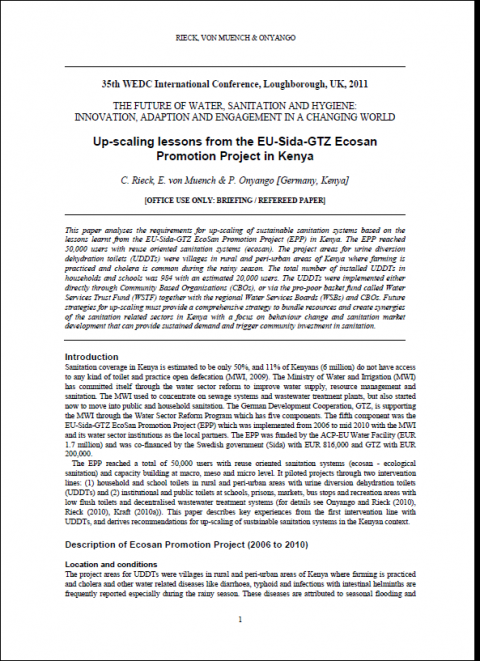Up-scaling lessons from the EU-Sida-GTZ Ecosan Promotion Project in Kenya
Rieck, C., von Muench, E. and Onyango, P. (2011)

Published in: 2011
Publisher:
Paper presented at the 35th WEDC International Conference: "The Future of Water, Sanitation and Hygiene - Innovation, Adaption and Engagement in a Changing World". Loughborough, United Kingdom
Author:
Rieck, C., von Muench, E. and Onyango, P.
Uploaded by:
SuSanA secretariat
Partner profile:
common upload
5008 Views
60 Downloads
Content - Summary
This paper analyses the requirements for up-scaling of sustainable sanitation systems based on the lessons learnt from the EU-Sida-GTZ EcoSan Promotion Project (EPP) in Kenya. The EPP reached 50,000 users with reuse oriented sanitation systems (ecosan). The project areas for urine diversion dehydration toilets (UDDTs) were villages in rural and peri-urban areas of Kenya where farming is practiced and cholera is common during the rainy season. The total number of installed UDDTs in households and schools was 984 with an estimated 20,000 users. The UDDTs were implemented either directly through Community Based Organisations (CBOs), or via the pro-poor basket fund called Water Services Trust Fund (WSTF) together with the regional Water Services Boards (WSBs) and CBOs. Future strategies for up-scaling must provide a comprehensive strategy to bundle resources and create synergies of the sanitation related sectors in Kenya with a focus on behaviour change and sanitation market development that can provide sustained demand and trigger community investment in sanitation.
Bibliographic information
Rieck, C., von Muench, E. and Onyango, P. (2011). Up-scaling lessons from the EU-Sida-GTZ Ecosan Promotion Project in Kenya. Paper presented at the 35th WEDC International Conference: "The Future of Water, Sanitation and Hygiene - Innovation, Adaption and Engagement in a Changing World". Loughborough, United Kingdom
Filter tags
English Peri-urban Rural Sub-Saharan Africa Urine diversion dehydration toilets (UDDTs)















